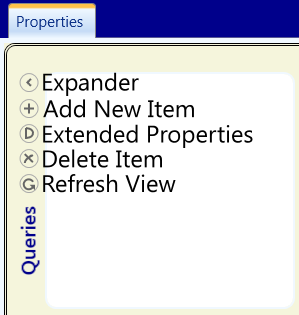The Designer's interface reflects the three main components of DataConnect. It also includes a Welcome section.
Properties Panel
All tabs except the Welcome tab have Properties sub-tab. Down the left hand side of the Properties tab you will see the Properties Panel.

The Expander allows you to hide and show the properties panel. This is useful when you don't have much room on your screen.
The Add New Item icon allows you to add a new connection, query or web service, depending on where you are in the application.
The Extended Properties icon on the Query tab is a D for Design mode. This lets you design the currently selected query. On the Web Service tab it is a P for Publish. This enters the web service publishing system.
The Delete Item icon deletes the currently selected item.
The Refresh View icon fetches updated information for the tab you are currently on.
Welcome

The welcome tab is where you will find blogs, wiki and update information for Flynet DataConnect. Keep an eye on this page for tips, tutorials and other useful news.
There is also a copy of the End User Licence Agreement, and the option to turn off the automatic loading of the welcome web page.
Connections

Here you create, view, edit and remove connections to your data sources. You start by pressing the plus (+) icon at the left hand side to add a new connection. You then fill out the details needed, press test to make sure everything is ok, optionally select the catalog/ schema/ database, and then press save.
Queries

This is where you work with queries. By pressing the plus (+) icon at the left hand side, you add a new query. You give it a name, and select which connection it uses. You can then either double-click on the connection name on the left hand side column, or you can select the query, and press the Design (D) icon at the left hand side to open the query designer.
Once in designer mode you can either use the drag-and-drop query builder (if you are using a compatible data source), or you can switch to manual entry mode and type SQL directly.
In UI mode, you can double click or drag tables, columns, views, stored procedures and SQL functions on to the design canvas. You build these 'tiles' up to make your query. You can drag tiles around your query, you can even drop them inside each other. You can remove tiles by hovering over them, and pressing the (X) icon that appears. You can also single click a tile to see the many options you have for that tile.
In SQL text mode, you can enter your SQL manually. You can get as complex as you need.
At the bottom, you can switch to the Data Preview tab, where you can run your query and see the results.
Once you are finished with your query, you press save at the bottom right hand side, and close the current designer tab, at the top.
You can have more than one query open at a time, and they will appear as tabs along the top.
Web Services

The last tab is where you define and publish your web services. As with connections and queries, you start by pressing the plus icon (+) at the left hand side to add a new web service.
Then you can give your service a name, and select which queries are included (linked) in this web service. Once you have done this, you can press the save button at the bottom right hand side.
You can then either double-click on the name of the web service in the left hand column, or select the service, and press the Publish icon (P) at the left hand side. This opens the web service publishing interface.
You then press the Publish button, and DataConnect will create and publish your web service into your local IIS web server.
You can press the Test button to see the web service. The first time you test, you have to reserve a licence by invoking the CheckLicense web method. Once that is done, you can run any of your own queries.
If you close the publishing window, you will see that at the bottom of your web service definition, there is a list of 'WSDL' connections. These WSDL links are what third party tools (such as SAP BusinessObjects Dashboard Design/ Xcelsius) need to access your web service.
